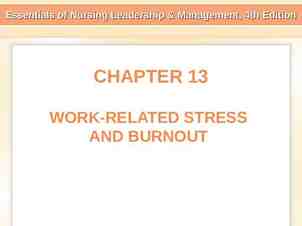Jump Start 1. Using Google text (466453) 2. Text “define
35 Slides3.46 MB

Jump Start 1. Using Google text (466453) 2. Text “define reform” 3. Write down the definition in your journal 4. What would you reform? How would you accomplish the task?
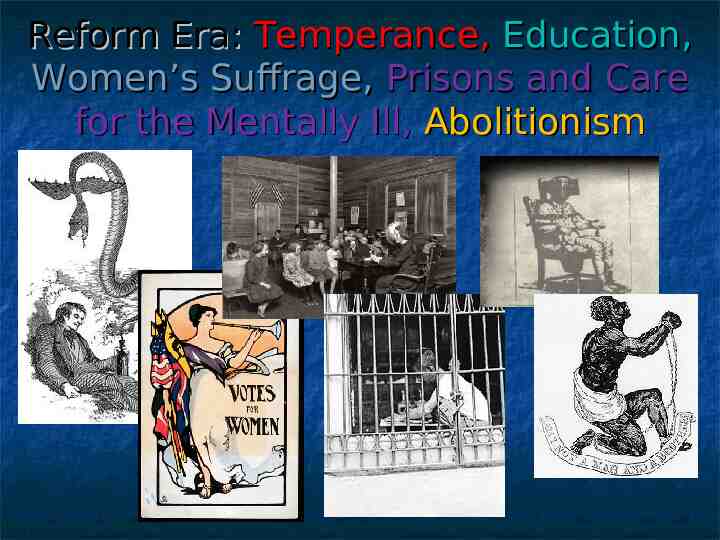
Reform Era: Temperance, Education, Women’s Suffrage, Prisons and Care for the Mentally Ill, Abolitionism
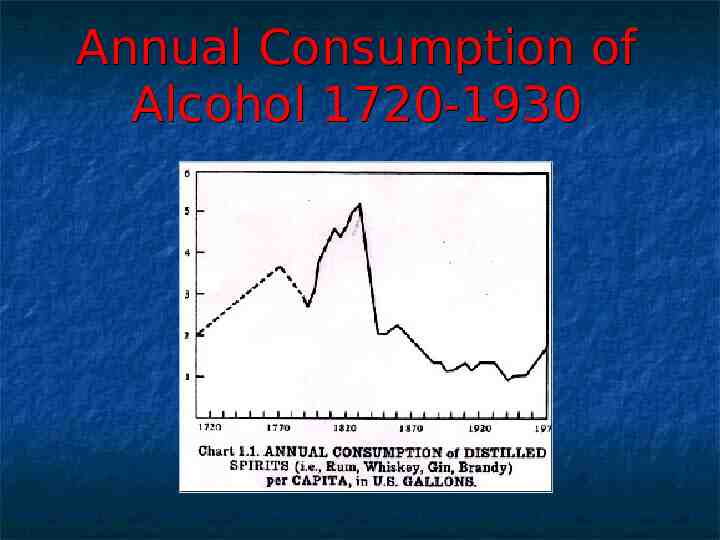
Annual Consumption of Alcohol 1720-1930
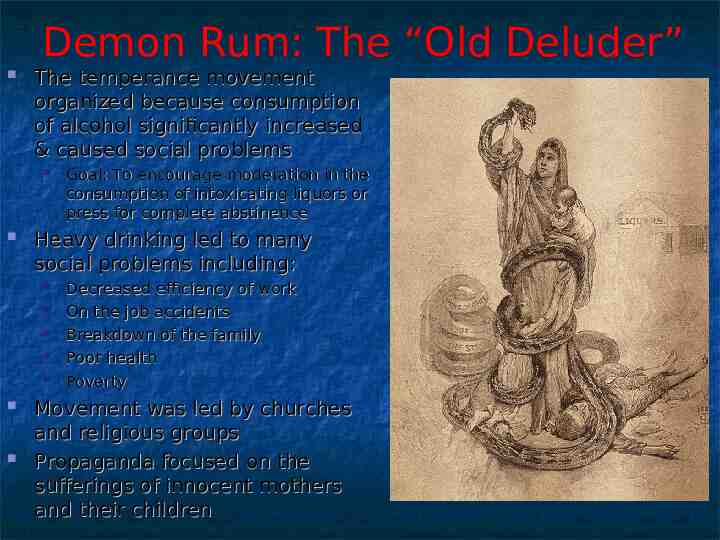
Demon Rum: The “Old Deluder” The temperance movement organized because consumption of alcohol significantly increased & caused social problems Heavy drinking led to many social problems including: Goal: To encourage moderation in the consumption of intoxicating liquors or press for complete abstinence Decreased efficiency of work On the job accidents Breakdown of the family Poor health Poverty Movement was led by churches and religious groups Propaganda focused on the sufferings of innocent mothers and their children
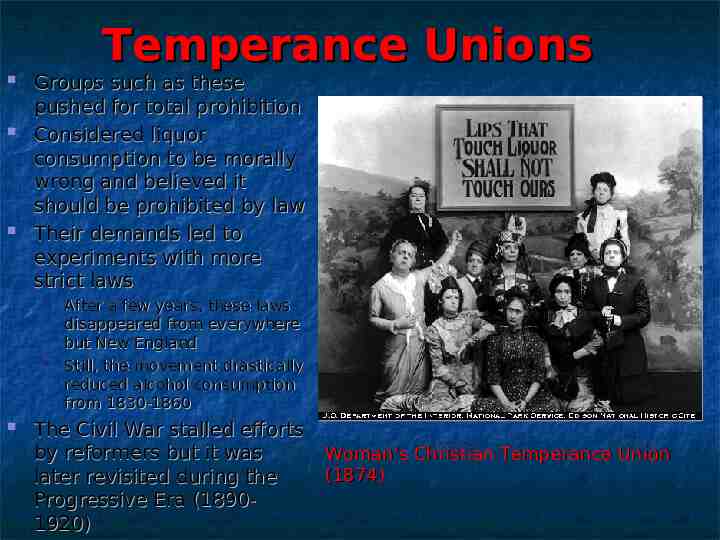
Temperance Unions Groups such as these pushed for total prohibition Considered liquor consumption to be morally wrong and believed it should be prohibited by law Their demands led to experiments with more strict laws After a few years, these laws disappeared from everywhere but New England Still, the movement drastically reduced alcohol consumption from 1830-1860 The Civil War stalled efforts by reformers but it was later revisited during the Progressive Era (18901920) Woman's Christian Temperance Union (1874)
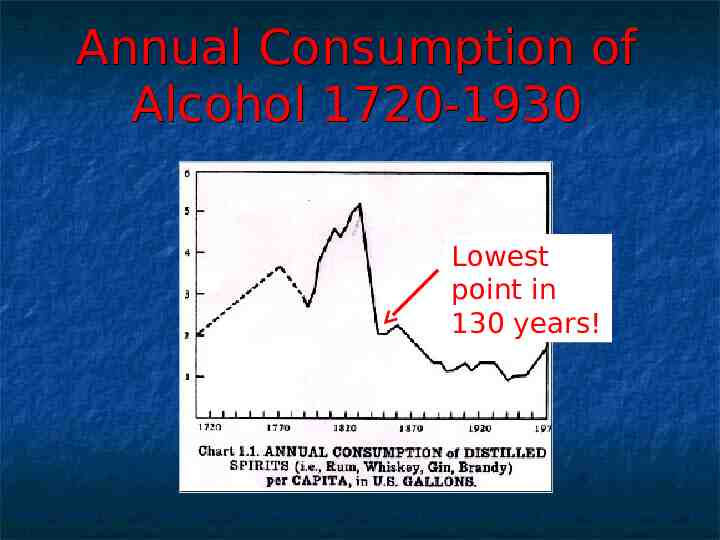
Annual Consumption of Alcohol 1720-1930 Lowest point in 130 years!
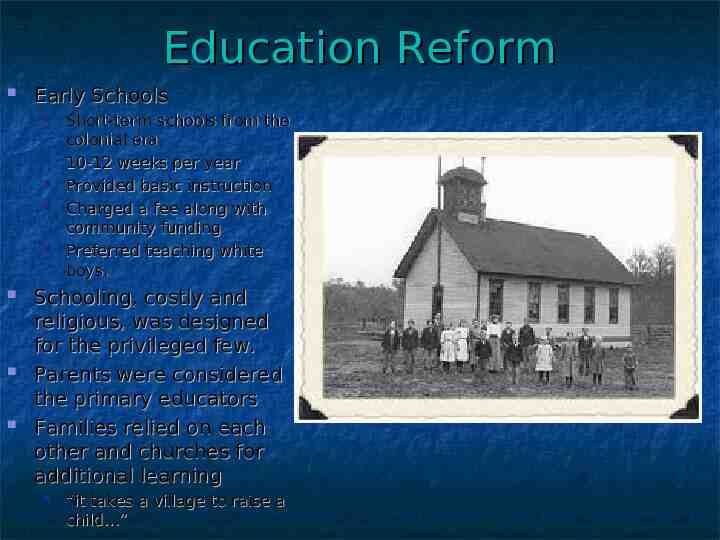
Education Reform Early Schools Short-term schools from the colonial era 10-12 weeks per year Provided basic instruction Charged a fee along with community funding Preferred teaching white boys. Schooling, costly and religious, was designed for the privileged few. Parents were considered the primary educators Families relied on each other and churches for additional learning “it takes a village to raise a child ”
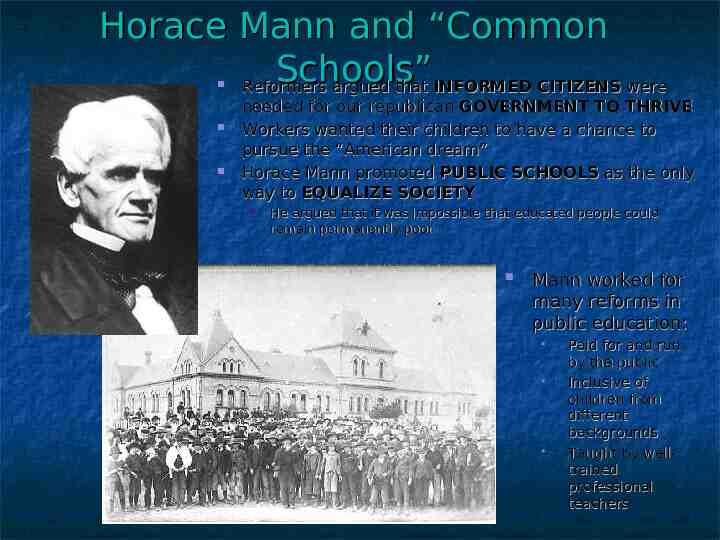
Horace Mann and “Common Schools” Reformers argued that INFORMED CITIZENS were needed for our republican GOVERNMENT TO THRIVE Workers wanted their children to have a chance to pursue the “American dream” Horace Mann promoted PUBLIC SCHOOLS as the only way to EQUALIZE SOCIETY He argued that it was impossible that educated people could remain permanently poor Mann worked for many reforms in public education: Paid for and run by the public Inclusive of children from different backgrounds Taught by welltrained professional teachers
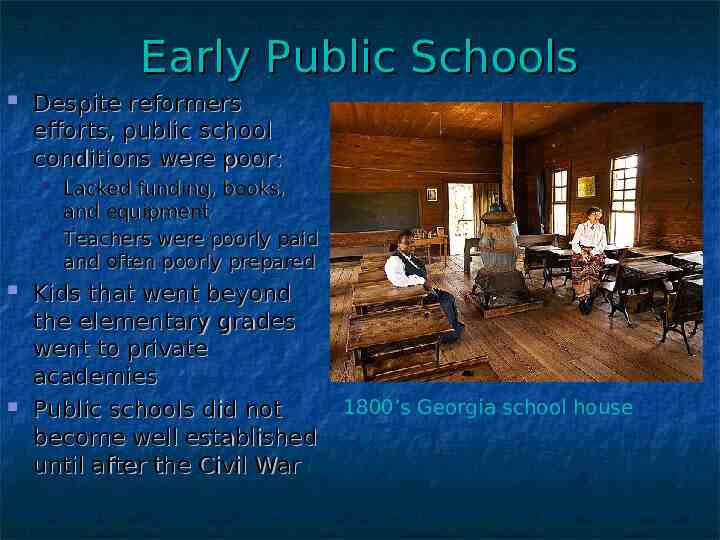
Early Public Schools Despite reformers efforts, public school conditions were poor: Lacked funding, books, and equipment Teachers were poorly paid and often poorly prepared Kids that went beyond the elementary grades went to private academies Public schools did not become well established until after the Civil War 1800’s Georgia school house
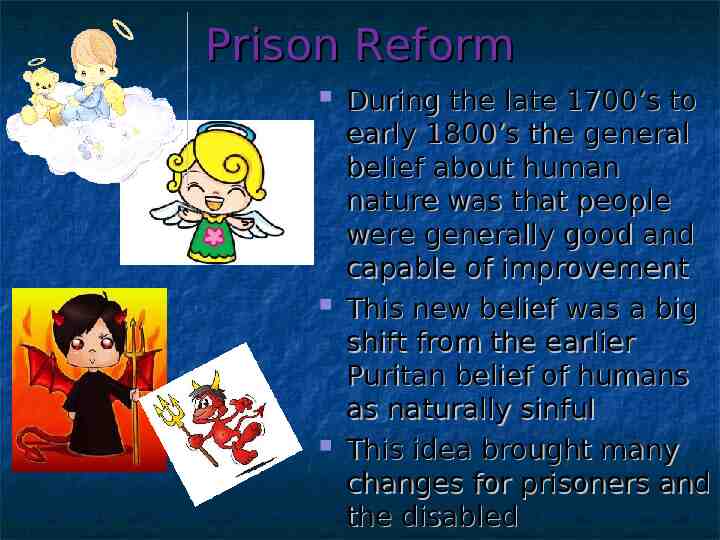
Prison Reform During the late 1700’s to early 1800’s the general belief about human nature was that people were generally good and capable of improvement This new belief was a big shift from the earlier Puritan belief of humans as naturally sinful This idea brought many changes for prisoners and the disabled
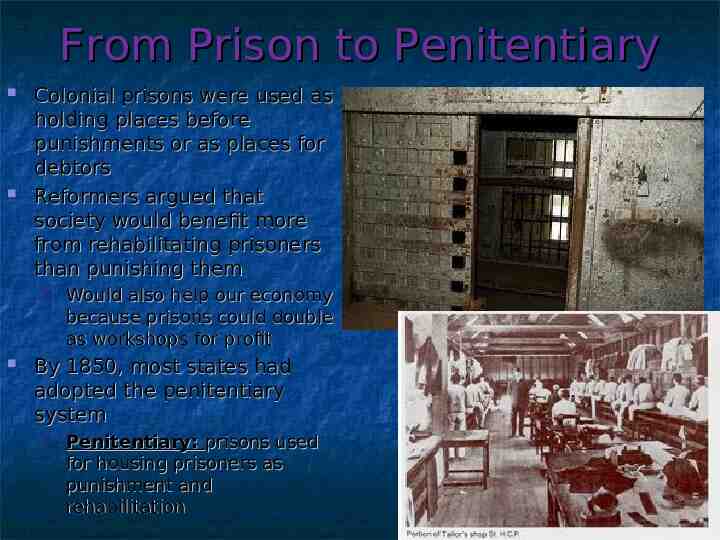
From Prison to Penitentiary Colonial prisons were used as holding places before punishments or as places for debtors Reformers argued that society would benefit more from rehabilitating prisoners than punishing them Would also help our economy because prisons could double as workshops for profit By 1850, most states had adopted the penitentiary system Penitentiary: prisons used for housing prisoners as punishment and rehabilitation
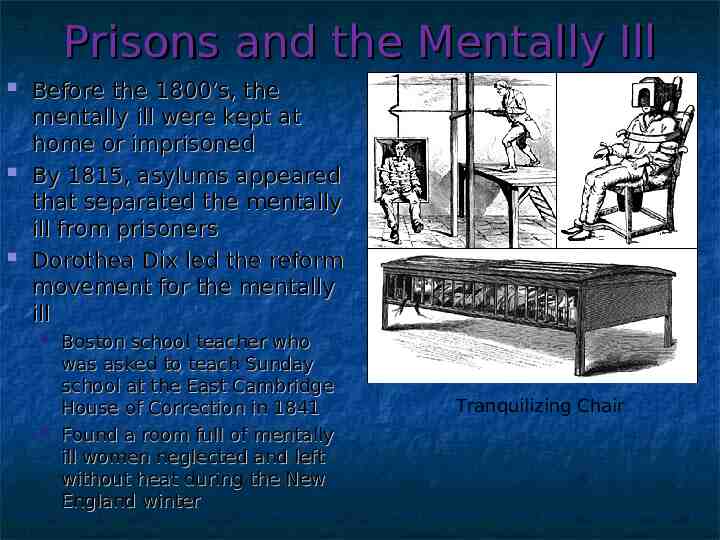
Prisons and the Mentally Ill Before the 1800’s, the mentally ill were kept at home or imprisoned By 1815, asylums appeared that separated the mentally ill from prisoners Dorothea Dix led the reform movement for the mentally ill Boston school teacher who was asked to teach Sunday school at the East Cambridge House of Correction in 1841 Found a room full of mentally ill women neglected and left without heat during the New England winter Tranquilizing Chair
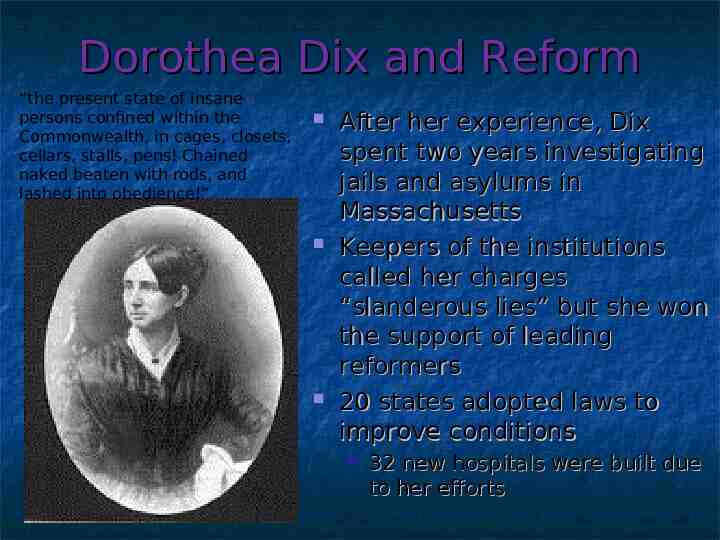
Dorothea Dix and Reform “the present state of insane persons confined within the Commonwealth, in cages, closets, cellars, stalls, pens! Chained naked beaten with rods, and lashed into obedience!” After her experience, Dix spent two years investigating jails and asylums in Massachusetts Keepers of the institutions called her charges “slanderous lies” but she won the support of leading reformers 20 states adopted laws to improve conditions 32 new hospitals were built due to her efforts
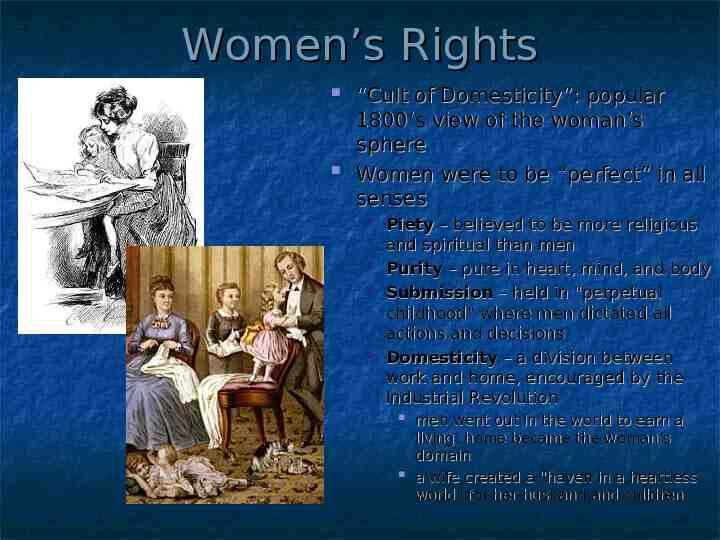
Women’s Rights “Cult of Domesticity”: popular 1800’s view of the woman’s sphere Women were to be “perfect” in all senses Piety – believed to be more religious and spiritual than men Purity – pure in heart, mind, and body Submission – held in "perpetual childhood" where men dictated all actions and decisions Domesticity – a division between work and home, encouraged by the Industrial Revolution men went out in the world to earn a living, home became the woman's domain a wife created a "haven in a heartless world" for her husband and children
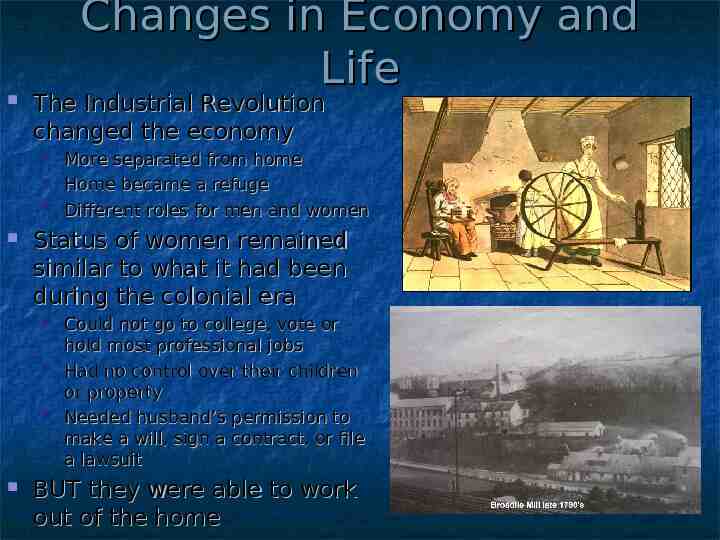
Changes in Economy and Life The Industrial Revolution changed the economy Status of women remained similar to what it had been during the colonial era More separated from home Home became a refuge Different roles for men and women Could not go to college, vote or hold most professional jobs Had no control over their children or property Needed husband’s permission to make a will, sign a contract, or file a lawsuit BUT they were able to work out of the home
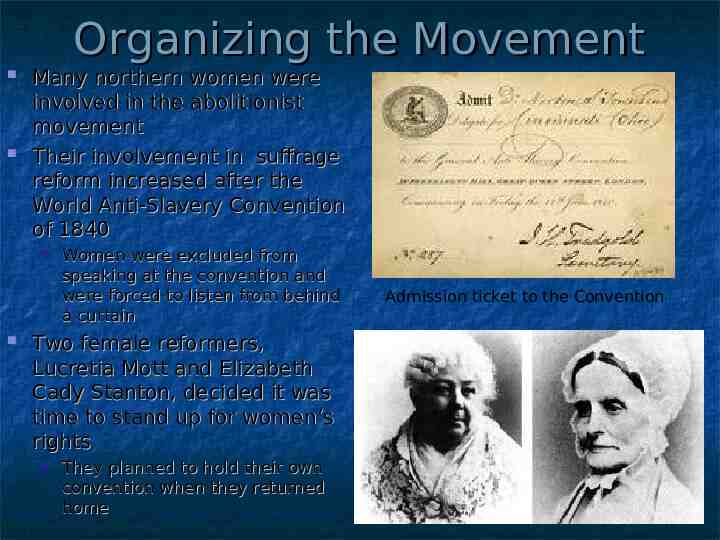
Organizing the Movement Many northern women were involved in the abolitionist movement Their involvement in suffrage reform increased after the World Anti-Slavery Convention of 1840 Women were excluded from speaking at the convention and were forced to listen from behind a curtain Two female reformers, Lucretia Mott and Elizabeth Cady Stanton, decided it was time to stand up for women’s rights They planned to hold their own convention when they returned home Admission ticket to the Convention
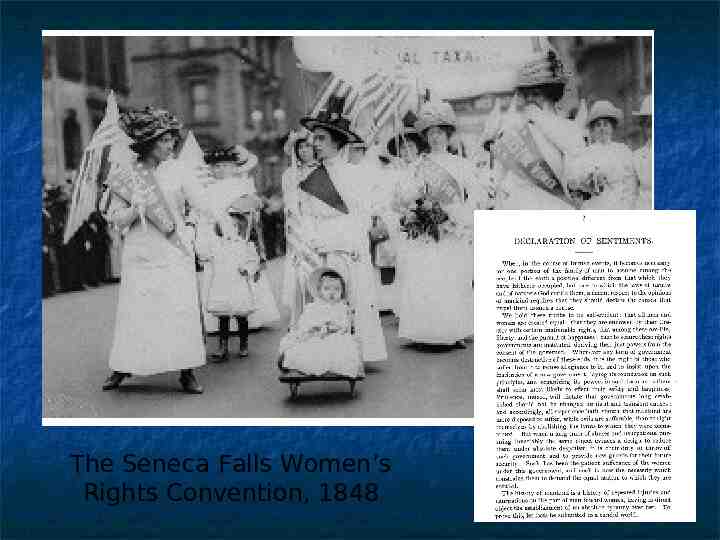
The Seneca Falls Women’s Rights Convention, 1848
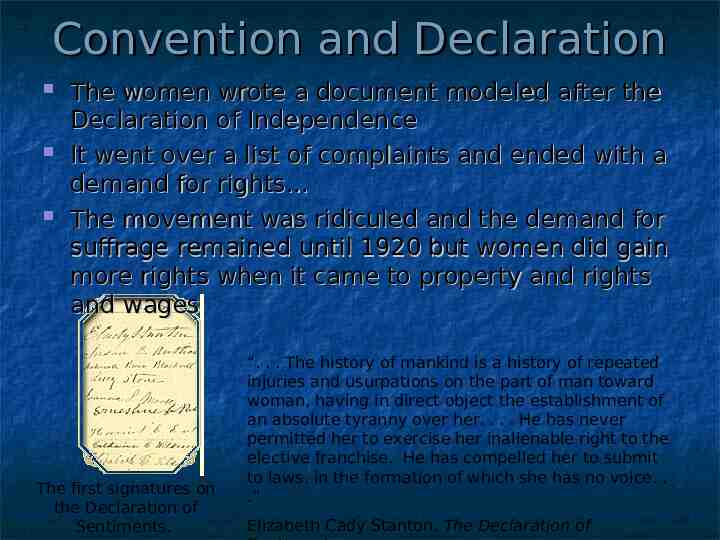
Convention and Declaration The women wrote a document modeled after the Declaration of Independence It went over a list of complaints and ended with a demand for rights. The movement was ridiculed and the demand for suffrage remained until 1920 but women did gain more rights when it came to property and rights and wages The first signatures on the Declaration of Sentiments. “. . . The history of mankind is a history of repeated injuries and usurpations on the part of man toward woman, having in direct object the establishment of an absolute tyranny over her. . . . He has never permitted her to exercise her inalienable right to the elective franchise. He has compelled her to submit to laws, in the formation of which she has no voice. . .” Elizabeth Cady Stanton, The Declaration of
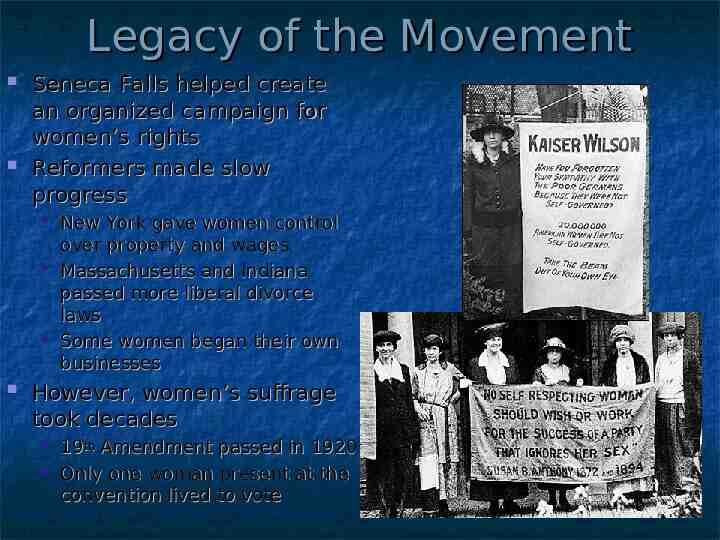
Legacy of the Movement Seneca Falls helped create an organized campaign for women’s rights Reformers made slow progress New York gave women control over property and wages Massachusetts and Indiana passed more liberal divorce laws Some women began their own businesses However, women’s suffrage took decades 19th Amendment passed in 1920 Only one woman present at the convention lived to vote
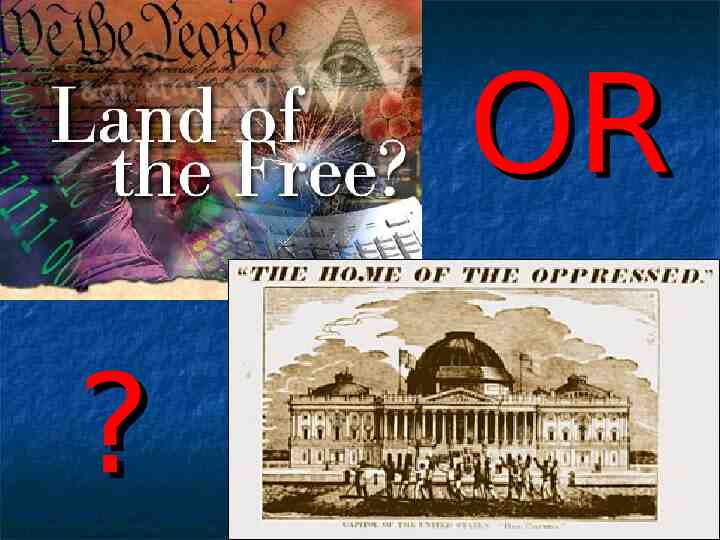
OR ?
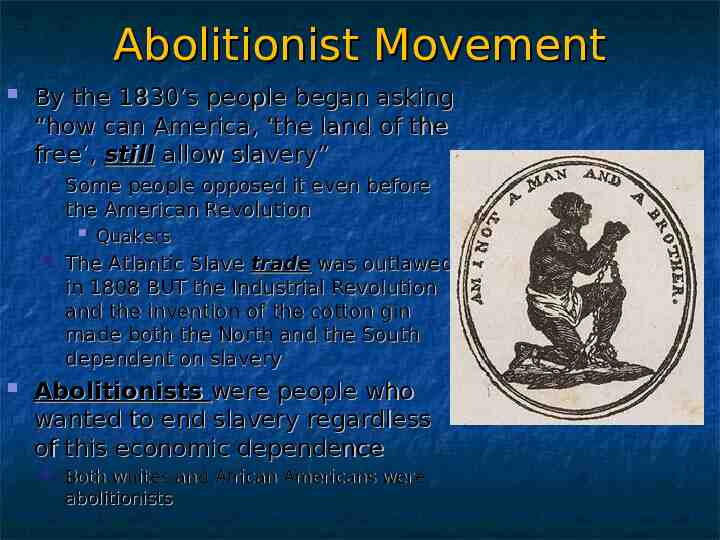
Abolitionist Movement By the 1830’s people began asking “how can America, ‘the land of the free’, still allow slavery” Some people opposed it even before the American Revolution Quakers The Atlantic Slave trade was outlawed in 1808 BUT the Industrial Revolution and the invention of the cotton gin made both the North and the South dependent on slavery Abolitionists were people who wanted to end slavery regardless of this economic dependence Both whites and African Americans were abolitionists
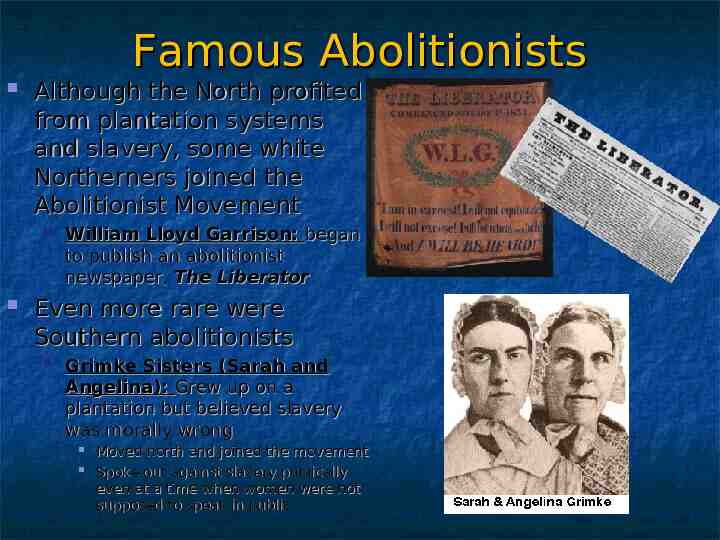
Famous Abolitionists Although the North profited from plantation systems and slavery, some white Northerners joined the Abolitionist Movement William Lloyd Garrison: began to publish an abolitionist newspaper, The Liberator Even more rare were Southern abolitionists Grimke Sisters (Sarah and Angelina): Grew up on a plantation but believed slavery was morally wrong Moved north and joined the movement Spoke out against slavery publically even at a time when women were not supposed to speak in public
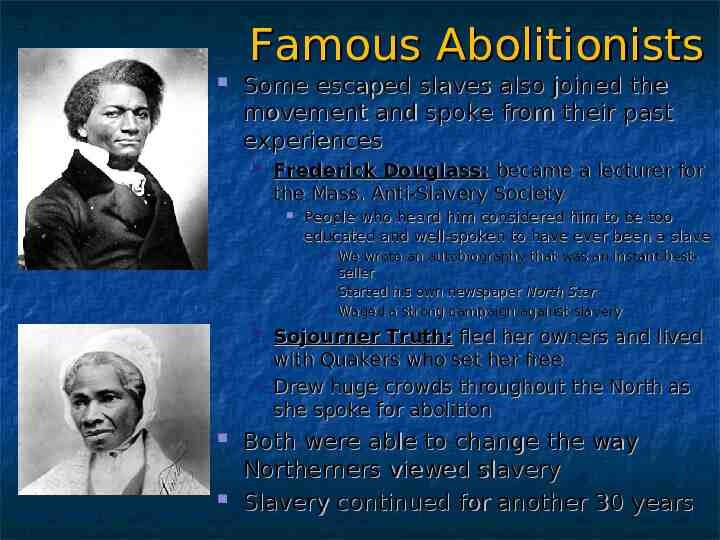
Famous Abolitionists Some escaped slaves also joined the movement and spoke from their past experiences Frederick Douglass: became a lecturer for the Mass. Anti-Slavery Society People who heard him considered him to be too educated and well-spoken to have ever been a slave We wrote an autobiography that was an instant bestseller Started his own newspaper North Star Waged a strong campaign against slavery Sojourner Truth: fled her owners and lived with Quakers who set her free Drew huge crowds throughout the North as she spoke for abolition Both were able to change the way Northerners viewed slavery Slavery continued for another 30 years
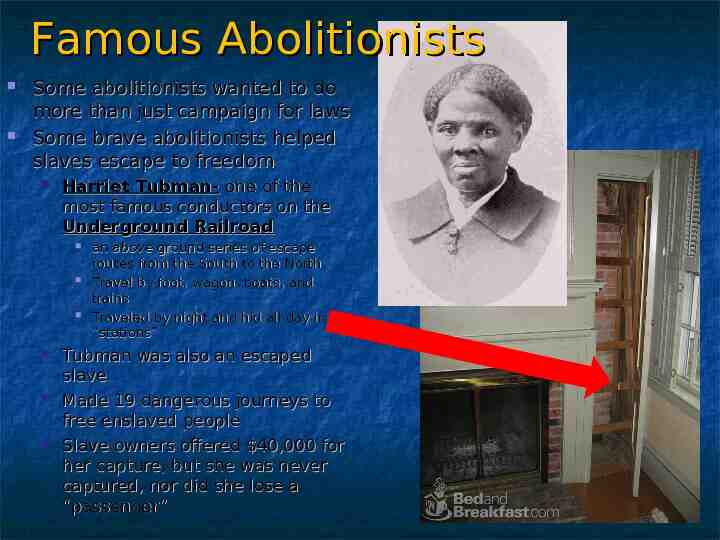
Famous Abolitionists Some abolitionists wanted to do more than just campaign for laws Some brave abolitionists helped slaves escape to freedom Harriet Tubman- one of the most famous conductors on the Underground Railroad an above ground series of escape routes from the South to the North Travel by foot, wagon, boats, and trains Traveled by night and hid all day in “stations” Tubman was also an escaped slave Made 19 dangerous journeys to free enslaved people Slave owners offered 40,000 for her capture, but she was never captured, nor did she lose a “passenger”
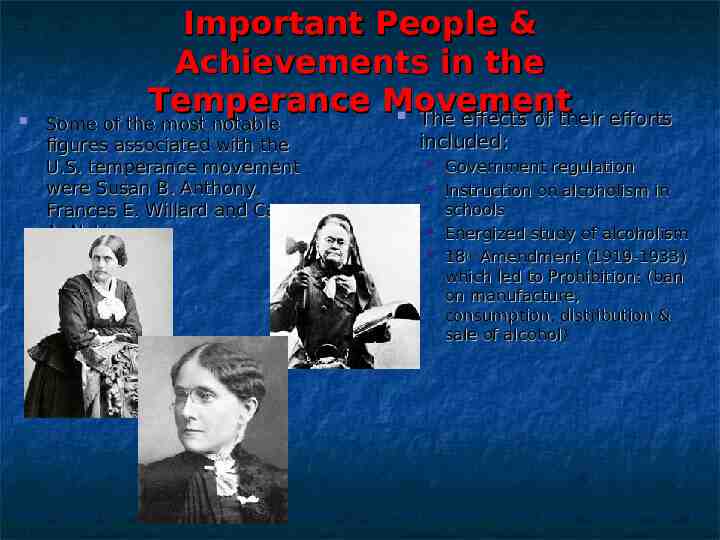
Important People & Achievements in the Temperance Movement The effects of their efforts Some of the most notable figures associated with the U.S. temperance movement were Susan B. Anthony, Frances E. Willard and Carry A. Nation included: Government regulation Instruction on alcoholism in schools Energized study of alcoholism 18th Amendment (1919-1933) which led to Prohibition: (ban on manufacture, consumption, distribution & sale of alcohol)
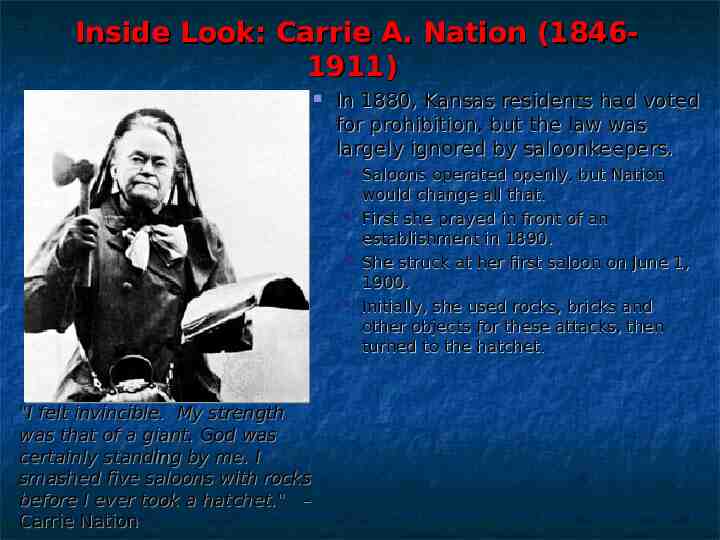
Inside Look: Carrie A. Nation (18461911) In 1880, Kansas residents had voted for prohibition, but the law was largely ignored by saloonkeepers. "I felt invincible. My strength was that of a giant. God was certainly standing by me. I smashed five saloons with rocks before I ever took a hatchet." – Carrie Nation Saloons operated openly, but Nation would change all that. First she prayed in front of an establishment in 1890. She struck at her first saloon on June 1, 1900. Initially, she used rocks, bricks and other objects for these attacks, then turned to the hatchet.
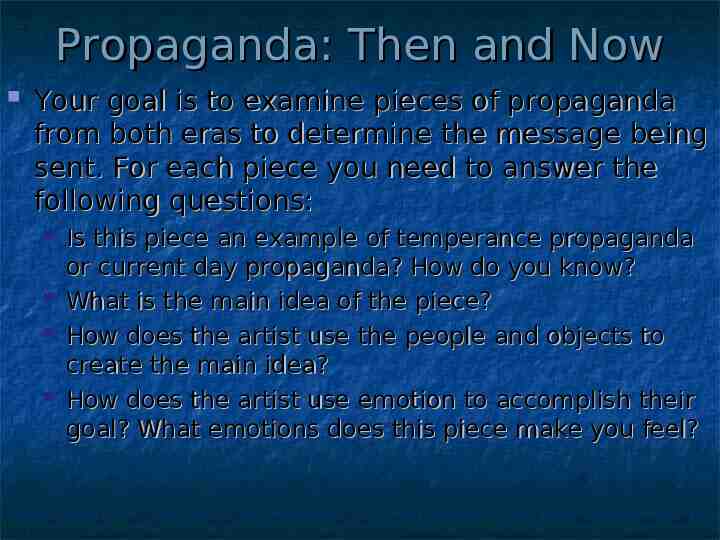
Propaganda: Then and Now Your goal is to examine pieces of propaganda from both eras to determine the message being sent. For each piece you need to answer the following questions: Is this piece an example of temperance propaganda or current day propaganda? How do you know? What is the main idea of the piece? How does the artist use the people and objects to create the main idea? How does the artist use emotion to accomplish their goal? What emotions does this piece make you feel?
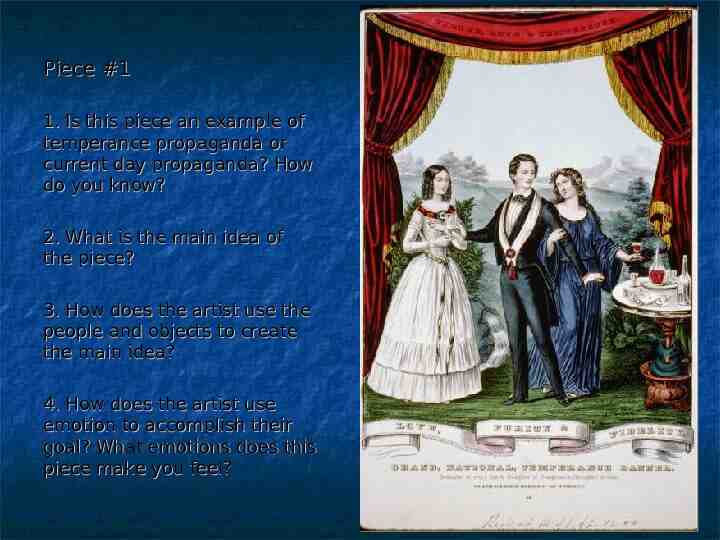
Piece #1 1. Is this piece an example of temperance propaganda or current day propaganda? How do you know? 2. What is the main idea of the piece? 3. How does the artist use the people and objects to create the main idea? 4. How does the artist use emotion to accomplish their goal? What emotions does this piece make you feel?
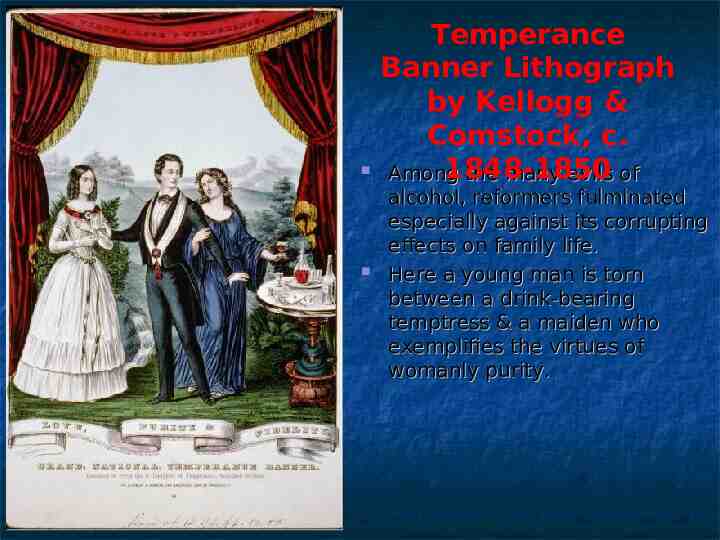
Temperance Banner Lithograph by Kellogg & Comstock, c. 1848-1850 Among the many evils of alcohol, reformers fulminated especially against its corrupting effects on family life. Here a young man is torn between a drink-bearing temptress & a maiden who exemplifies the virtues of womanly purity.
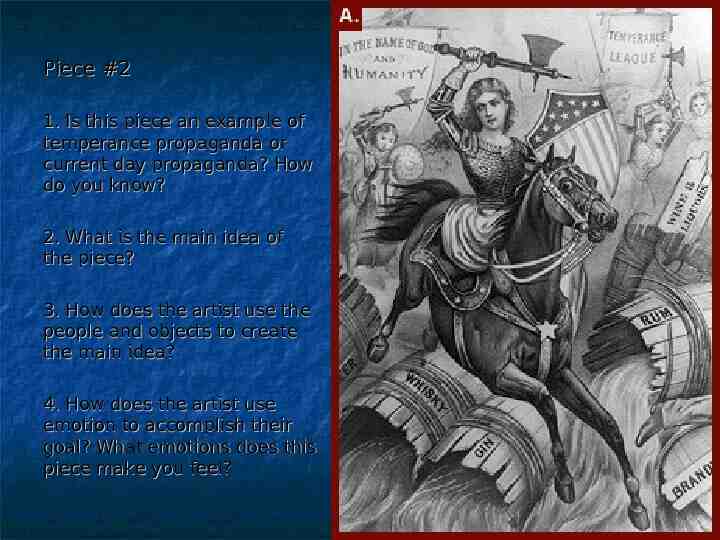
Piece #2 1. Is this piece an example of temperance propaganda or current day propaganda? How do you know? 2. What is the main idea of the piece? 3. How does the artist use the people and objects to create the main idea? 4. How does the artist use emotion to accomplish their goal? What emotions does this piece make you feel?
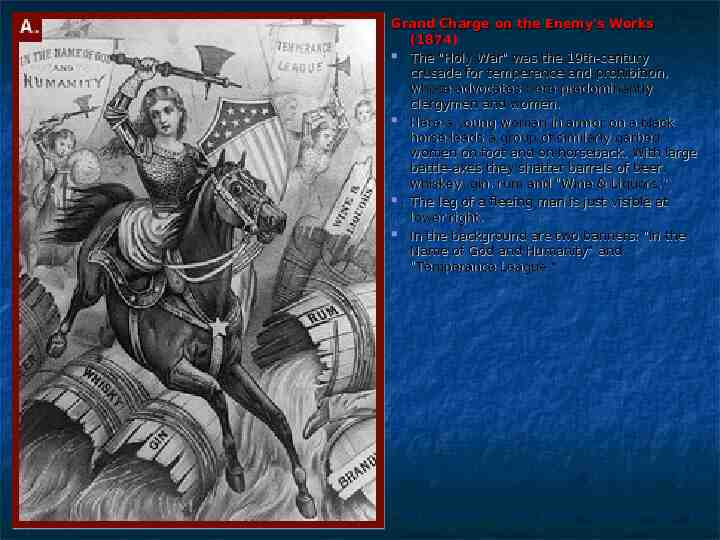
Grand Charge on the Enemy's Works (1874) The "Holy War" was the 19th-century crusade for temperance and prohibition, whose advocates were predominantly clergymen and women. Here a young woman in armor on a black horse leads a group of similarly garbed women on foot and on horseback. With large battle-axes they shatter barrels of beer, whiskey, gin, rum and "Wine & Liquors.“ The leg of a fleeing man is just visible at lower right. In the background are two banners: "In the Name of God and Humanity" and "Temperance League."

Piece #3 1. Is this piece an example of temperance propaganda or current day propaganda? How do you know? 2. What is the main idea of the piece? 3. How does the artist use the people and objects to create the main idea? 4. How does the artist use emotion to accomplish their goal? What emotions does this piece make you feel?

Piece #4 1. Is this piece an example of temperance propaganda or current day propaganda? How do you know? 2. What is the main idea of the piece? 3. How does the artist use the people and objects to create the main idea? 4. How does the artist use emotion to accomplish their goal? What emotions does this piece make you feel?
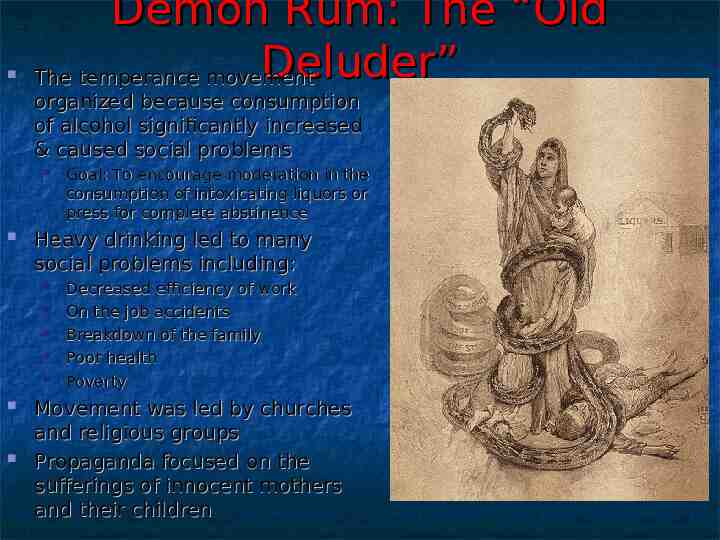
Demon Rum: The “Old Deluder” The temperance movement organized because consumption of alcohol significantly increased & caused social problems Heavy drinking led to many social problems including: Goal: To encourage moderation in the consumption of intoxicating liquors or press for complete abstinence Decreased efficiency of work On the job accidents Breakdown of the family Poor health Poverty Movement was led by churches and religious groups Propaganda focused on the sufferings of innocent mothers and their children
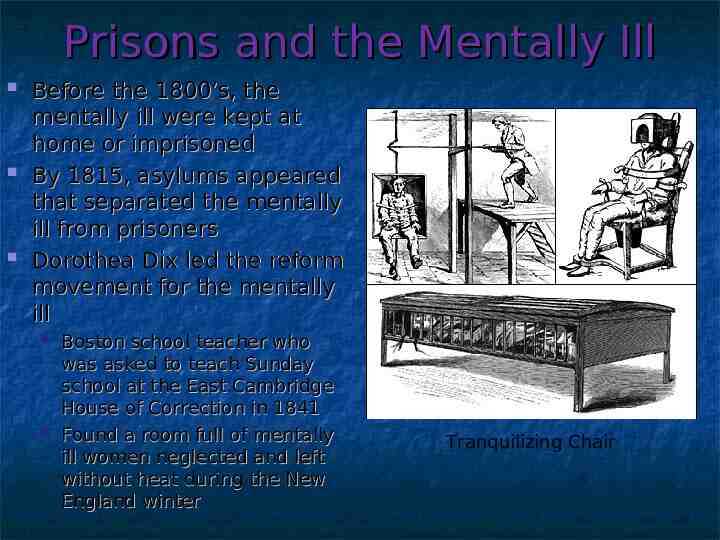
Prisons and the Mentally Ill Before the 1800’s, the mentally ill were kept at home or imprisoned By 1815, asylums appeared that separated the mentally ill from prisoners Dorothea Dix led the reform movement for the mentally ill Boston school teacher who was asked to teach Sunday school at the East Cambridge House of Correction in 1841 Found a room full of mentally ill women neglected and left without heat during the New England winter Tranquilizing Chair


